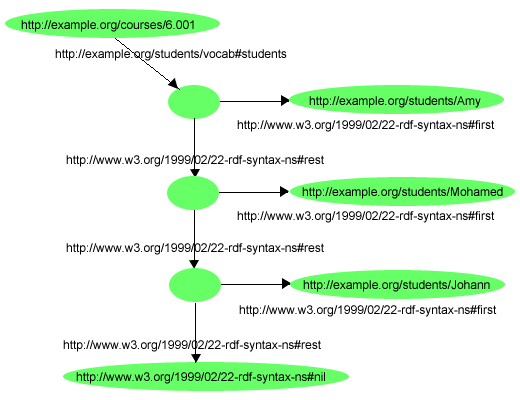@prefix rdfs: <http://www.w3.org/2000/01/rdf-schema#> .
@prefix rdf: <http://www.w3.org/1999/02/22-rdf-syntax-ns#> .
@prefix : <http://example.org/students/vocab#> .
:students rdfs:range rdf:List.
<http://example.org/courses/6.001> :students (
<http://example.org/students/Amy>
<http://example.org/students/Mohamed>
<http://example.org/students/Johann> ) .
The SPARQL query to be answered looks like
PREFIX list: <http://www.w3.org/2000/10/swap/list#>
PREFIX : <http://example.org/students/vocab#>
CONSTRUCT
{ ?S :follows ?C }
WHERE
{ ?C :students ?L. ?S list:in ?L }
The predicate list:in is true iff the object is a list and the subject is in that list. One way to test the list:in relationship is via ruleset [RPO-RULES] that are loaded with the RDF dataset in inference engines such as [CWM] and [EULER]. That way the command line cwm students.n3 rpo-rules.n3 -think -sparql=students.rq returns the RDF/N3 graph
@prefix : <http://example.org/students/vocab#> .
<http://example.org/students/Amy>
:follows <http://example.org/courses/6.001> .
<http://example.org/students/Johann>
:follows <http://example.org/courses/6.001> .
<http://example.org/students/Mohamed>
:follows <http://example.org/courses/6.001> .
Traversing trees
The tree to be to be queried is

The RDF/N3 for this example looks like
@prefix rdfs: <http://www.w3.org/2000/01/rdf-schema#> .
@prefix rdf: <http://www.w3.org/1999/02/22-rdf-syntax-ns#> .
@prefix : <http://example.org/plants/vocab#> .
:Tree rdfs:subClassOf :Plant.
:Vegetable rdfs:subClassOf :Plant.
:Oak rdfs:subClassOf :Tree.
:Walnut rdfs:subClassOf :Tree.
:Pear rdfs:subClassOf :Tree.
:Salad rdfs:subClassOf :Vegetable.
:Potato rdfs:subClassOf :Vegetable.
:FrenchOak rdfs:subClassOf :Oak.
:AmericanOak rdfs:subClassOf :Oak.
To only get the "branch" of classes that are subclasses of Tree the SPARQL query to be answered looks like
PREFIX rdfs: <http://www.w3.org/2000/01/rdf-schema#>
PREFIX : <http://example.org/plants/vocab#>
CONSTRUCT
{ ?C rdfs:subClassOf :Tree }
WHERE
{ ?C rdfs:subClassOf :Tree }
The command line euler plants.n3 rpo-rules.n3 -think -query plants.rq returns the RDF/N3 graph
@prefix rdfs: <http://www.w3.org/2000/01/rdf-schema#>.
@prefix : <http://example.org/plants/vocab#>.
:Oak rdfs:subClassOf :Tree.
:Walnut rdfs:subClassOf :Tree.
:Pear rdfs:subClassOf :Tree.
:FrenchOak rdfs:subClassOf :Tree.
:AmericanOak rdfs:subClassOf :Tree.

